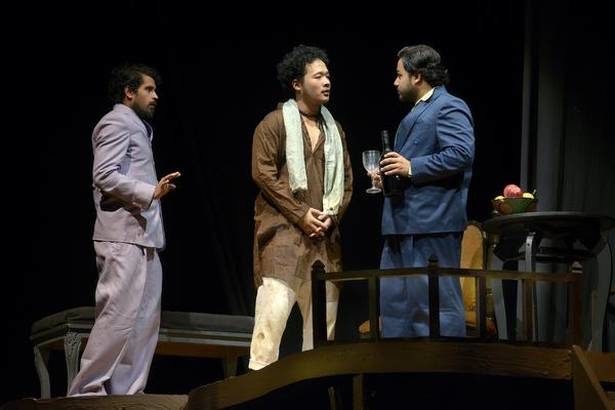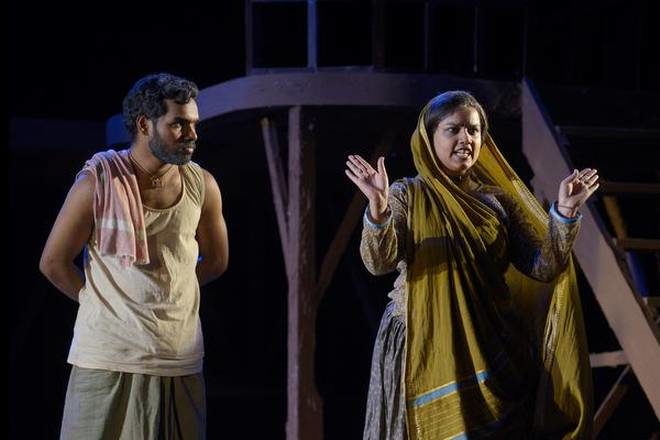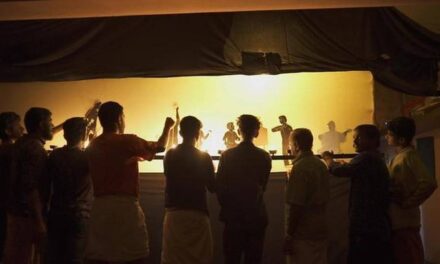Excellent music and performances rendered Asif Ali’s Nachyo Bahut Gopal a fine depiction of those condemned to a life of scavenging.
The first year students of National School of Drama projected characters in flesh and blood from Amritlal Nagar’s popular novel Nachyo Bahut Gopal in Hindi at Abhimanch this past week. The protagonist lives in an environment which is shockingly degrading, dehumanizing, and decadent. We watch women and men carrying feces in a basket on their heads. The narrative unfolds through the interactions between the character of writer and ageing Nirgun, revealing an array of dismal and gloomy images of her life. The ageing Nirgun has come to terms with her life, though there is still a tinge of bitterness in her voice.
She reveals that the little Nirgun was brought up by her maternal grandfather and grandmother after the death of her mother. This little Brahmin girl was taken by her lumpen father to an upper caste lady with shady character who engages a young man to teach her English. They fall in love but abort the fetus because the teacher is not ready to marry her. They tread different paths but Nirgun’s first lover never forgets her, while she continues to fall to the lower depths of human existence.
Pain of isolation
Adapted and directed by Asif Ali, protagonist Nirgun becomes a sex slave of an old and impotent rich man suffering from the morbid desire to have more mistresses. Whenever he goes out for business, he keeps Nirgun under lock and key inside his huge haveli. Young and beautiful as she is, he is suspicious about her character. Suffering from the pain of isolation, one day she manages to escape with a young man who comes to remove human excrement. Then begins another ordeal of humiliation, after she joins the ranks of Mehars and forced to perform the disgraceful duty of the socially most depressed Mehar community.
The novel has a vast canvas and vibrates with a large number of characters and their uneventful lives. The stage version tends to be loosely joined with different social situations. The pace remains slow from the start and it hardly gains momentum and the show goes on for two hours and forty five minutes. This makes viewing tedious. There are different strands. The Mehar lover of Nirgun, Mohan, is sketchily drawn who finally becomes a dacoit.

A scene from the play. Photo Credit: Special arrangement
Music by Kajal Ghosh, a veteran stage music director, is remarkable for its ingenious experiment to conceive fusion to create the right mood and provide background for the action. There are nine musical instruments including sarangi and flute. The strain of sarangi imparts depth to poignant situations that stirs our hearts. The use of Western music invokes the atmosphere prevailing in Christian missionaries living in camps. The vocal music drawn from folk and a bhajan are rendered in mellifluous voices, richly contributing to reveal the emotional state of the characters.
Sandeep Bhattacharya’s two-tier set reflects stark reality of the world in which Dalits live. On the upper tier characters of higher social status enact their roles. On the lower part Dalits are condemned to live in misery. When Mehars need water for the cleaning purpose, it is poured from the bucket from the upper layer to avoid their touch. The designer has aptly devised ladders from either side of the set to enable the performers for ascending and descending from one tier to another.
To give some indication of the present state of Dalit movement, the director could have composed some songs to convey this idea of revolutionary changes that have taken place in Dalit movements in recent years.
The entire cast gives fine performances, especially Shilpa Bharti in the role of young Nirgun who creates a sensitive portrayal of her character transforming it into an image of eternally suffering humanity with no hope of redemption.
Smriti Mishra’s old Nirgun comes to terms with her sufferings, reflecting on her past in philosophical vein. Paalin Kabak as Mohan, who loves young Nirgun with warmth and passion and finally turns into a dacoit, displays vitality and emotional intensity. Md. Saquib Shaikh in various roles, acts with remarkable ease, especially as a teacher always remembering his beloved young Nirgun with empathy.
This article originally appeared in The Hindu on June 22, 2018, and has been reposted with permission.
This post was written by the author in their personal capacity.The opinions expressed in this article are the author’s own and do not reflect the view of The Theatre Times, their staff or collaborators.
This post was written by Diwan Singh Bajeli.
The views expressed here belong to the author and do not necessarily reflect our views and opinions.

















